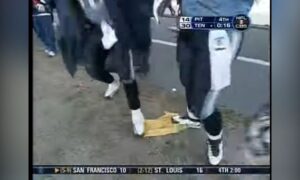Matthew Marczi
Earlier this week, we have devoted two articles to the pass blocking prowess of the Pittsburgh Steelers’ running backs last season, and how it will be a chore for Le’Veon Bell to get up to speed with the rest of the group.
However, it is fair to note that the 2012 season was a recent high water mark for the Steelers backfield with respect to pass protection. Even Isaac Redman, who was the best in pass protection in the league a year ago, had his troubles in 2011, when he saw 77 snaps as a pass blocker.
Last season, Redman gave up just one hurry all season—in the last game of the year, in fact. In 2011, however, he gave up two sacks, one hit, and three hurries, which equates to a Pass Blocking Efficiency of 93.5. Going by that metric, Redman’s PBE would be nearly half a percentage below the mean from a year ago, when the league-wide PBE was 93.94.
One player who did not do the Steelers many favors in this area over his short tenure with the team was Rashard Mendenhall. Drafted in the first round in 2008, he missed most of his rookie season before winning the starting job in 2009, and then went on to miss most of the 2012 season.
As previously noted, Mendenhall played just four snaps in pass protection last season, and did so without allowing any pressure. But that was not indicative of his overall game in this area. The numbers between 2009 and 2011 will be more telling.
Conveniently, Pro Football Focus has already done some of the legwork in this area, as they have compiled a piece that looks at the pass blocking efficiency of backs league-wide over the three-year period between 2009 and 2011. The results? Mendenhall had the ninth-worst Pass Blocking Efficiency over that period of all backs with at least 100 snaps in pass protection.
While he can take solace in the fact that names such as Adrian Peterson and Chris Johnson ranked eighth and sixth, respectively, it is certainly a dubious distinction to be included in a bottom ten list of nearly any kind.
Between 2009 and 2011, Mendenhall played 148 snaps in pass protection. In those 148 snaps, he surrendered 14 total pressures, including four sacks and three hits. That is a success rate of just 90.54, which, by last year’s standards, is easily below league average.
In terms of Pass Blocking Efficiency, which, again, is a Pro Football Focus metric that takes into account the greater severity of sacks by counting hits and hurries as just three-fourths of a pressure, Mendenhall scored 92.23. That, too, again, is well below the average numbers that were put up league-wide a season ago, when the mean PBE came in at 93.94.
Interestingly, however, Mendenhall actually had a very representative season in 2011, when he allowed just one hit and one hurry on 42 snaps in pass protection. That earned him a PBE of 96.4, which did place him in the top 20 of backs with at least 40 snaps in pass protection that year. 2011 was a fine season; it was the prior two seasons in which he really struggled.
Taking a look back at 2009, Mendenhall was asked to pass protect more than he should have, playing over a quarter of his passing snaps in pass protection. In his 266 passing snaps, 68 were as a blocker.
In those 68 snaps, Mendenhall surrendered seven pressures, which was a success rate of 89.7. In terms of Pass Blocking Efficiency, he rated at 91.2, as three of his seven pressures were sacks.
2010 was an even worse showing, as he surrendered five pressures in 30 less snaps in pass protection. That was a success rate of 86.8. With one of his five pressures being sacks, his Pass Blocking Efficiency came in at 89.5.
Neither of those figures for either season cracked the top 50 at his position in those respective years. As relayed previously, the Arizona Cardinals had one of the least successful backfields a season ago in pass protection, so it will be interesting to see which Rashard Mendenhall they will be getting in 2013, if he will be asked to pass protect much at all.
Of course, Mendenhall is not part of the Steelers in 2013, and he played only a marginal role in 2012, so his absence does not do much of anything to reshape Pittsburgh’s narrative. Both Redman and Dwyer showed their prowess in pass protection last season, and both are still on the roster. Baron Batch and Will Johnson also held their own in their first seasons as active contributors. How many of them will make it onto the 53-man roster, and will they be able to live up to their own performances from a year ago?





